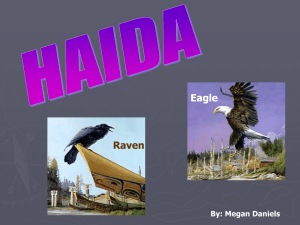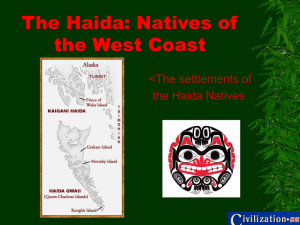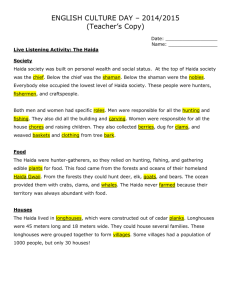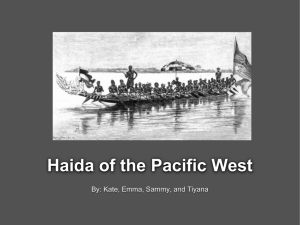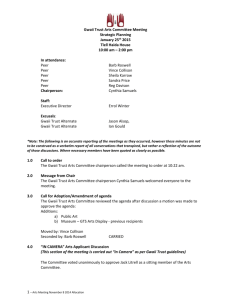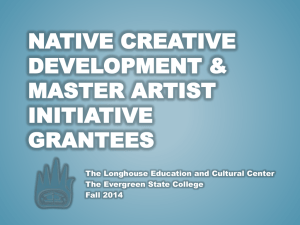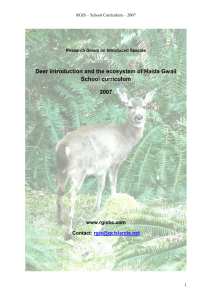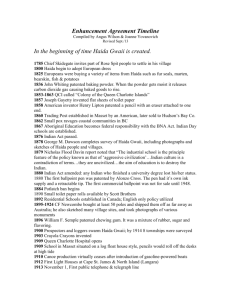Lesson - The Historical Thinking Project
advertisement
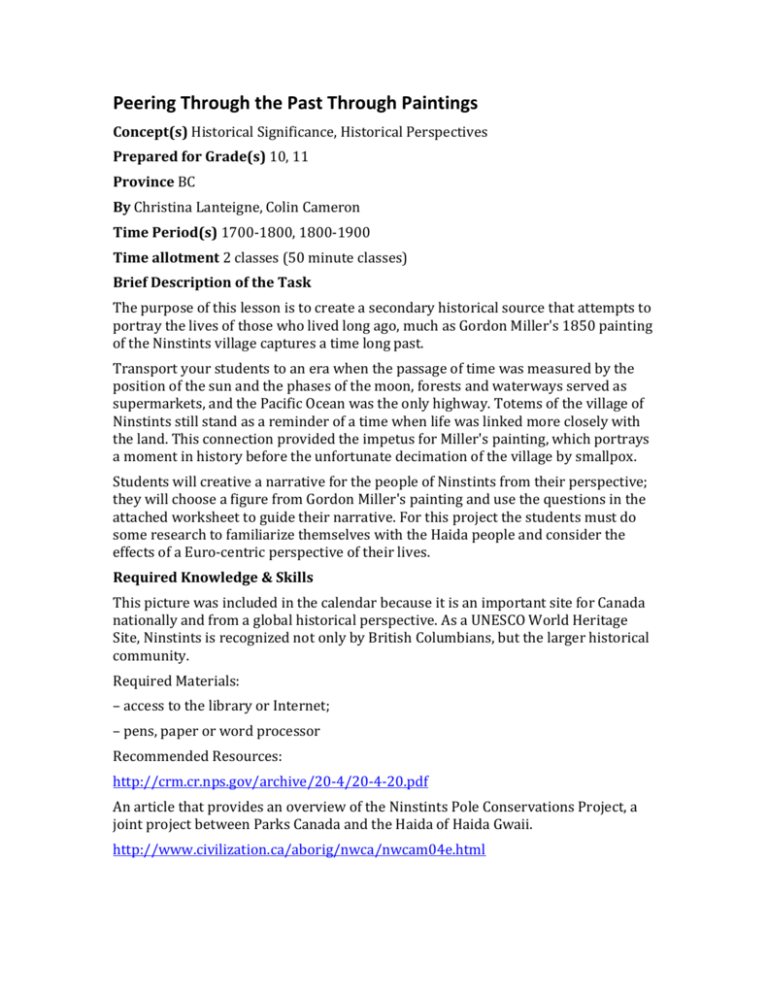
Peering Through the Past Through Paintings Concept(s) Historical Significance, Historical Perspectives Prepared for Grade(s) 10, 11 Province BC By Christina Lanteigne, Colin Cameron Time Period(s) 1700-1800, 1800-1900 Time allotment 2 classes (50 minute classes) Brief Description of the Task The purpose of this lesson is to create a secondary historical source that attempts to portray the lives of those who lived long ago, much as Gordon Miller's 1850 painting of the Ninstints village captures a time long past. Transport your students to an era when the passage of time was measured by the position of the sun and the phases of the moon, forests and waterways served as supermarkets, and the Pacific Ocean was the only highway. Totems of the village of Ninstints still stand as a reminder of a time when life was linked more closely with the land. This connection provided the impetus for Miller's painting, which portrays a moment in history before the unfortunate decimation of the village by smallpox. Students will creative a narrative for the people of Ninstints from their perspective; they will choose a figure from Gordon Miller's painting and use the questions in the attached worksheet to guide their narrative. For this project the students must do some research to familiarize themselves with the Haida people and consider the effects of a Euro-centric perspective of their lives. Required Knowledge & Skills This picture was included in the calendar because it is an important site for Canada nationally and from a global historical perspective. As a UNESCO World Heritage Site, Ninstints is recognized not only by British Columbians, but the larger historical community. Required Materials: – access to the library or Internet; – pens, paper or word processor Recommended Resources: http://crm.cr.nps.gov/archive/20-4/20-4-20.pdf An article that provides an overview of the Ninstints Pole Conservations Project, a joint project between Parks Canada and the Haida of Haida Gwaii. http://www.civilization.ca/aborig/nwca/nwcam04e.html A web page dedicated to the Ninstints paintings by Gordon Miller. It includes a reproduction of the painting in the British Columbia 150 Years Calendar by Historica. http://www.greatcanadianparks.com/bcolumbia/gwaiinp/index.htm A very detailed site about Gwaii Haanas National Park. It includes references to the village of Ninstints and a quiz at the end of a virtual tour. http://www.civilization.ca/aborig/haida/haindexe.html A Canadian Heritage site about the Haida. http://www.thecanadianencyclopedia.com/index.cfm?PgNm=TCE&Params=A1ART A0... The Canadian Encyclopedia article "Gwaii Haanas National Park Reserve and Haida Heritage Site." http://www.thecanadianencyclopedia.com/index.cfm?PgNm=TCE&Params=A1ART A0... The Canadian Encyclopedia article "Haida." http://www.canadianencyclopedia.ca/index.cfm?PgNm=TCE&Params=M1ARTM00 12523 Maclean's Magazine article "People of Haida Gwaii Fight for Their Past, Future" about the Haida village of Skidegate. Detailed Instructions Lesson Preparation 1. Using materials from The Canadian Encyclopedia on-line, have students research the Haida of the Queen Charlotte Islands, known to them as Haida Gwaii. Their research should reveal aspects of the lives of the Haida, including those who lived in Ninstints. Aspects should include, but not be limited to: – transportation; – diet; – spirituality; – social organization; – dress/attire; – accommodation (housing); – art and dance. 2. Preparation For Narrative& Historical Perspective Discussion / Summative Assessment: Lead a discussion, and have students copy notes from the board or an overhead projection, to answer the following questions pertaining to historical perspective taking and Gordon Miller's painting of Ninstints. Adopt the perspective of a Haida person living in Ninstints and answer the following questions: – What do you think of Gordon Miller? – What would you say to Gordon Miller about his understanding of life in your village? – What questions do you have for Gordon Miller, or anyone else? – Are you pleased with the efforts to save the totems in your village? – Are you pleased that UNESCO declared Ninstints a world heritage site? – Do you think that Gordon Miller\'s painting is a good way to represent your life and your village to the world? European culture? – From the evidence that you gathered about the 19th-century Haida of Ninstints, how would you look at the world today? Eg: regarding transportation, diet, community, even modern things like TV, video games etc… Would you be able to understand these concepts? Why or why not? – What are the elements from your lifestyle that suggest you would think that way? – What do you think presentism is and why is it important to consider when viewing the world from another time/perspective? 3. Narrative Writing Assignment / Formative Assessment: Have students write the narrative using the following instructions. You are a character in Gordon Miller\'s painting who has come back to life to share your life and views of the world today. Write a first person narrative (story) that outlines your life. Include details from your research AND from our historical perspective notes/class historical discussion questions. Remember that your views are limited to your time period; you should not be familiar with video games, the Internet, electricity, running water or toilets, cars, store-bought food or clothing, synthetic fabric, etc… Criteria: Students' narratives must: – include a creative title, name and date; – be double-spaced; – include proper spelling and grammar; – include details about the lives of the Haida. Outcomes Concepts in Historical Thinking: Historical Perspectives You should expect students to be able to: – understand the "past as a foreign country," with its different social, cultural, intellectual and even emotional contexts that shaped people's lives and actions; – recognize presentism in historical accounts; – use evidence and understanding of the historical context, to answer questions about why people acted as they did (or thought as they did) even when their actions seem at first irrational or inexplicable or different from what we would have done or thought. BC Prescribed Learning Outcomes Grade 9: Society and Culture: Europe and North America from 1500 to 1815 You should expect students to be able to: – analyze the relationship between Aboriginal people and Europeans and explain the role of each in the development of Canada; – describe daily life in Haida communities; – analyze roots of present-day regional, cultural and social issues within Canada Environment: Europe and North America from 1500 to 1815 You should expect students to be able to: – demonstrate an understanding of the ways in which Aboriginal people, particularly the Haida, interact with their environment. Grade 10: Applications of Social Studies You should expect students to be able to: – generate and critique different interpretations of primary and secondary resources; – assess and defend a variety of positions on controversial issues. Society and Culture: Canada from 1815 to 1914 You should expect students to be able to: – assess interactions between Aboriginal people and Europeans; – demonstrate awareness of ways the arts mirror and shape Canadian society.
